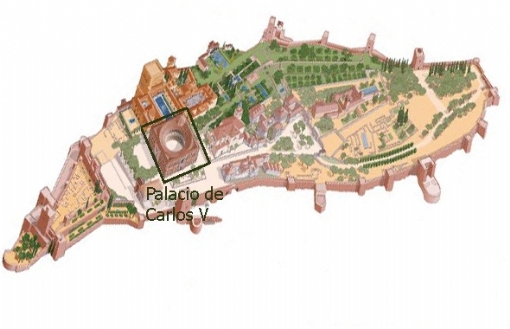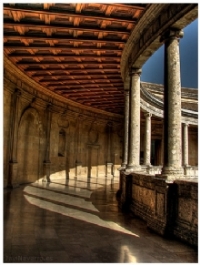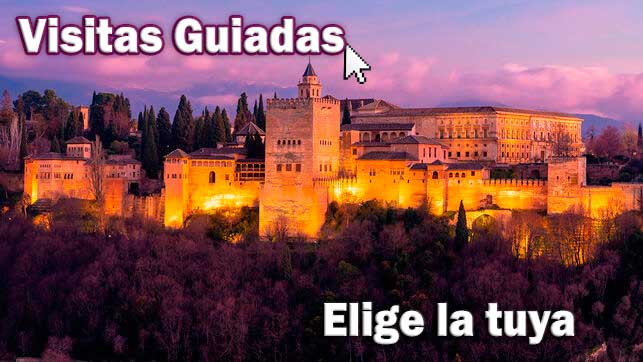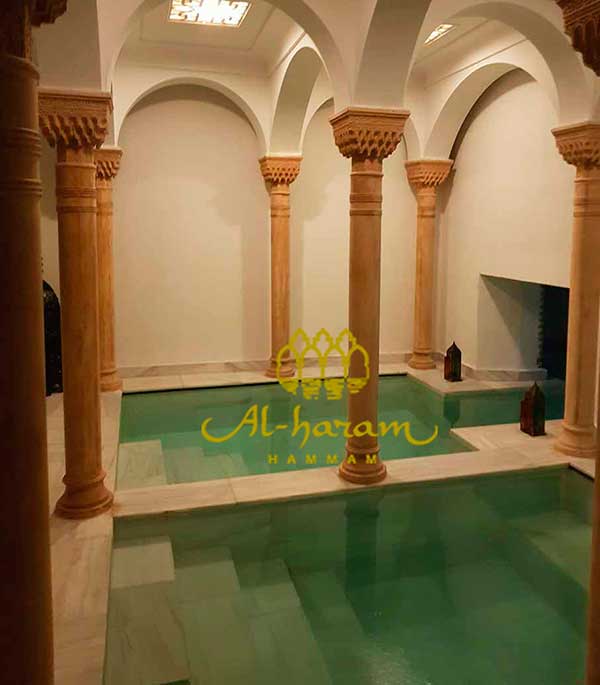- Page de Démarrage
- Guide Alhambra
- Domaines principaux Alhambra
- Carlos V Palace

Carlos V Palace
The origin of the Palace of Carlos V is due to the need for a place that meets all the comforts of the time for the emperor and his family, since the Alcazar, which was his summer residence, did not meet his needs.
The emperor ordered the construction of the palace next to the Alhambra to enjoy its wonders. The architect in charge of the work was Pedro Machuca, a lover of the rebirth of proven experience. The construction of the palace began in 1527 and financed in its entirety in 1957. The construction went through several stages, lack of funds, uprisings that stopped the works, and so on. The roofs sank by default.
The palace is square, with a main facade 63 meters wide by 17 meters high. Highlights its circular courtyard in the center, unique in style and the most outstanding work of the Renaissance in Spain. Only the south and west facades are decorated in their entirety. The north and east only partly, because the building is attached to the Alcazar of the Alhambra.
Being already the owner of America, Emperor Carlos V moved his court to the royal houses of the Alhambra, to spend the summer of 1526 there. The Emperor was then born to wish to make Granada one of his points of residence, so who planned to build a new palace, with greater comfort and more space than the Arab, but connected to it to continue enjoying it, continuing with it the work begun by his grandparents - the Catholic Monarchs -, and with the desire to convert this palace into the Great Aulic center of the Empire. Thus one of the best Renaissance works outside of Italy and the first great royal palace of the Spanish monarchs was carried out.

It was Don Luis Hurtado de Mendoza, who sought the economic means to cover the project: the taxes that the Moors had to pay in exchange for preserving some of their customs. Subsequently, other resources from the Alcazar of Seville and the Granada sugars had to be sought. The work was commissioned in 1527 from Toledo architect and painter Pedro Machuca, an artist who had trained in Italy with Michelangelo, assuming his main work for him. After his death, on June 4, 1550, it was entrusted to numerous architects, some as important as Juan de Orea, who performed the work of the Cathedral of Granada, or Juan de Minjares, rigger of the palaces of Aranjuez and El Escorial.
The building, of stonework, is square, and measures 63 m. of length and 17,40 of height in the main facades, being inscribed inside its circular patio, which determines a strange plant and of difficult use, unprecedented built. It is linked to the Arab Alcazar, so only the south and western facades are decorated, part of the north and only one half of the other. The building consists of two bodies: the lower one of Tuscan order, of padded work, with chopped ashlars and very outgoing pilasters in which large bronze rings are inserted to tie the horses. In the intermediate spaces of the pilasters, rectangular windows are opened and, on them, other circular ones (recently glazed), being understood along this body a wide poyo that forms the base of the palace.
Similar arrangement of holes and pilasters offers the second body, although it is much more ornate and, in it, under the circular windows, balconies with ornate lintels are opened. The pilasters are of Ionic order, supporting a Corinthian entablature.
The central part of the two main facades are occupied by magnificent marble covers of Sierra Elvira, which are the most beautiful of the Spanish Renaissance. The noon (looking at the Justice Tower) has the lower Ionic body; the pedestals that extend to the sides to support two lying lions have in their net low-reliefs with warrior, Roman, Arab, Turkish and Christian trophies; The door has a cornice and pediment with a relief of the Abundance in its eardrum and, on it, winged figures of Fame and Victory offering crowns to the victor and accompanied by geniecillos. The second body of this cover is Corinthian, and its double columns rest on pedestals with reliefs that form a balcony.
 The cover of the western side, which is considered the main entrance of the Palace, is of Doric order, with four groups of double striated columns, whose bases and capitals are beautifully adorned (on the left photo of one of the low-reliefs of the pedestals ). Three doors open between the columns: the central, large, supports the statue of a woman who holds a symbolic grenade in one of her hands and extends the other in a gesture of pointing, as if making the Emperor the offering of the palace. The other two doors are smaller and are adorned with groups of fruits in brackets and with medals in their eardrums. On these covers appear medallions framed in serpentine stone.
The cover of the western side, which is considered the main entrance of the Palace, is of Doric order, with four groups of double striated columns, whose bases and capitals are beautifully adorned (on the left photo of one of the low-reliefs of the pedestals ). Three doors open between the columns: the central, large, supports the statue of a woman who holds a symbolic grenade in one of her hands and extends the other in a gesture of pointing, as if making the Emperor the offering of the palace. The other two doors are smaller and are adorned with groups of fruits in brackets and with medals in their eardrums. On these covers appear medallions framed in serpentine stone.
As for the eastern façade (looking at Santa María de la Alhambra), a door on whose lintel the inscription «Imp. You fall Karolo V ». Another similar door is in the north facade, facing the current entrance of the Arab Alcazar and through it the underground dependencies of it have access.
The courtyard, high, is for its greatness and sumptuousness, one of the most beautiful creations of the Renaissance. Its wide circle, 30 m. in diameter, it occupies the center of the building and is surrounded by a wide porch with 32 Doric columns. The pudinga stone columns of Turro (Loja), correspond to many other pilasters that decorate the wall of the cloister, among which arches, niches and doors open to communicate with the various dependencies of the building. The same arrangement offers the upper part, which has Ionic columns supporting an entablature of Elvira stone that forms a ring of surprising execution.
Information for the visit to the Palace of Carlos V
No entry is required to visit the Palace of Carlos V, since it remains open at the same time as the Alhambra and is free.
As for museums, the one of Fine Arts is free for EU citizens upon presentation of passport, ID, etc; The price for other citizens is € 1.5. The Alhambra museum is free for all visitors.
Do you have any doubt? Call us
+34 958 91 80 29 From Monday to Friday 9.00 - 14.00 and 17.00 - 20.00Other Recommended Services
Choose your service




